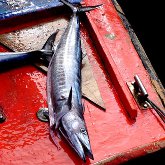Anglers Unite: Why the Fishing Community Should Be a Tight-Knit One
January 26, 2012Fish Recipe: Grilled Tilapia Topped With Fresh Pineapple Salsa
January 30, 2012Flying fish can be found in all of the world’s warmer ocean waters, and their signature leaps make them a sight to behold. Flying fish don’t fly, of course, but they certainly can give the illusion of flight by achieving speeds that allow them, with the help of their wing-like pectoral fins, to catch some serious air. Want to know more about this amazing example of the diversity of fish species on the planet today? Then read on!
- Flying fish are actually a family of fish called Exocoetidae – a family made up of over 60 known species of flying fish grouped into 9 genera.
- Predators of the flying fish include tuna, mackerel, swordfish, marlin, and other big fish. This is a big part of why various flying fish species have developed their unique escape method.
- Flying fish eat, among other things, the tiny organisms known as plankton.
- Flying fish can reach speeds of up to 43 MPH and have achieved heights as high as 20 feet above the water. The longest recorded flying fish flight time is 45 minutes, and these fish can glide up to 655 feet.
- To “fly,” a flying fish swims toward the surface at an upward angle, gaining speed as it goes. When it breaks the surface, it taxis by rapidly beating its tail while its lower half is still below the surface. Then it stretches its wings and is airborne.
- Flying fish don’t have to totally re-enter the water to continue a flight. Once they re-enter the water, they can taxi instead of fully submerging in the water. The longest consecutive series of flights? 1,312 feet!
- Like many species, flying fish are attracted to light, and anglers have taken advantage of this in the past and present. A canoe filled with enough water to sustain the fish without allowing them to escape is outfitted with lights and the fish fly right in.
- The Latin name Exocoetidae is a translation of the Ancient Greek term for flying fish, which translated literally to “sleeping outside.” The name came from the erroneous belief that flying fish would leave the water at night to sleep on land.
- The curve of a flying fish wing is very similar to a bird’s wing, and flying fish can change their flight lengths by responding to updrafts.
- In the Solomon Islands, flying fish are caught not with lures, but with nets! Fishermen hold out nets to catch them in mid-flight after attracting them with light on moonless nights.

